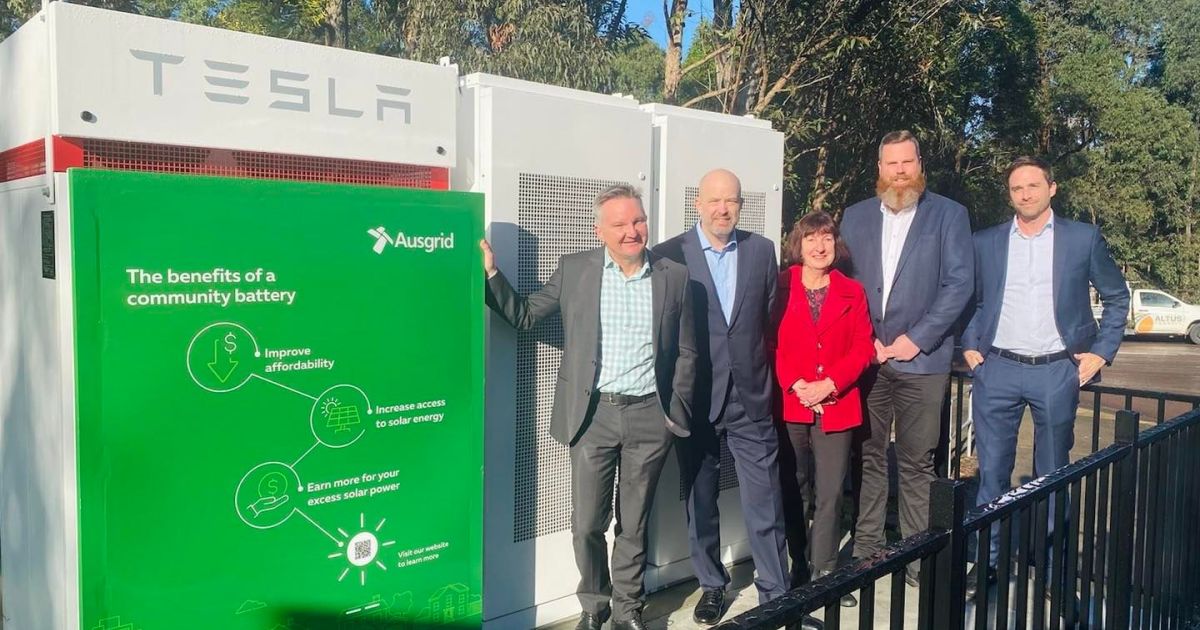Distributed Network Service Provider (DNSP) Ausgrid has taken the wraps off its Cameron Park Community Battery at Lake Macquarie in NSW; its third community battery on the east coast and the first outside Sydney.
There are a bunch of solar panels in Cameron Park – more than 4,180 small-scale systems have been installed with a collective capacity just north of 24MW. How many of those systems also have a home battery isn’t clear, but chances are it’s still a fairly small percentage given the cost of solar batteries.
In a trial being run by Ausgrid, eligible Cameron Park residents have been invited to virtually store their surplus solar power in Ausgrid’s new Tesla battery system.
How Ausgrid’s Community Battery Trial Works
It doesn’t cost anything to participate and residents don’t need to switch electricity provider or change their electricity plan. If accepted into the trial, a “smart measuring device” is installed in the switchboard of the participant’s home and access to a mobile app/online portal provided where energy imports, exports and credits can be viewed.
Participants can virtually store up to 10kWh of surplus solar electricity daily, which will be credited against their electricity use for that day. Each quarter Ausgrid will deposit “community battery credits” into participants’ bank accounts.
So, how much will participants be receiving? While it will vary depending on solar exports and energy usage patterns; Ausgrid says:
“We estimate that most participants on a time of use pricing plan would receive between $50 to $250 per year.”
The FAQ is a little vague on the financial benefits for solar owners in my opinion – they aren’t explained very well.
The trial doesn’t appear to be available right across Cameron Park, but just in a few streets. The two other locations where Ausgrid’s community battery trial is being run are Beacon Hill on Sydney’s Northern Beaches and Bankstown in Sydney’s West.
Further information on all three trials can be found here.
Community Batteries A “Win, Win, Win”
Federal Minister for Climate Change and Energy Chris “Community Battery” Bowen attended the launch last Wednesday.
“I want to congratulate Ausgrid for driving this important initiative and taking a leading role in trialling solutions that will form a big part of the future infrastructure of our energy system,” he said.
Member for Hunter Dan Repacholi was also present at the event.
“The Hunter has been the powerhouse of NSW for the last century, and we will continue to be the powerhouse of NSW with projects like this,” stated Mr. Repacholi. “I would encourage residents in Cameron Park take a look at the Battery and see if they are eligible to access the trial.”
Ausgrid says as well as benefiting solar owners, the use of community batteries can provide a better and cheaper alternative to traditional network investment. Boosting storage capacity in the energy system can reduce peak demand and put downward pressure on electricity prices for all.
“Community batteries are cheaper for the customer, better for the community and greener for the grid. It’s a win, win, win,” said Ausgrid Chief Customer Officer Rob Amphlett Lewis.


 RSS - Posts
RSS - Posts



Assuming storage of 10kWh per daily, and a maximum payout of $250 per year …
$250 / 365=$0.6849315068493151 per day
$0.6849315068493151 / 10 kWh
=6.849315068493151 per kWh.
Seems fairly low no?
Not that retailers are offering much for FiTs at present – they don’t really want you breaking even, let alone making money off solar. :-C
But you’ll still be getting your FIT. As I read the article to get the “community battery credits” costs you nothing….
George,
It is a great big heap of rip off the consumer .
When I decided to put solar panels on the house the feed in rate was 17c with payback on installation cost of around 4 to 5 years but the rate has been reduced several times since with an additional cost of additional hardware to meet ausgrids new safety requirements with the communities embedded circuit.
Now we are looking at 6 to 7 years payback together with a 35% increase in supply from AGL.
The wonders of modern life where most of the so called leaders in government and power supply companies have never had a real job.